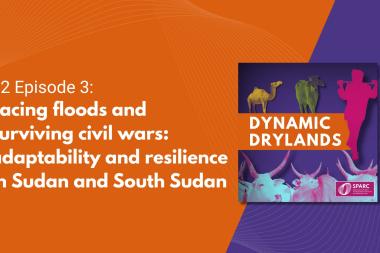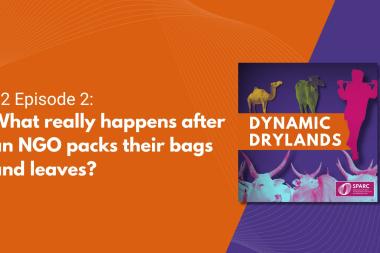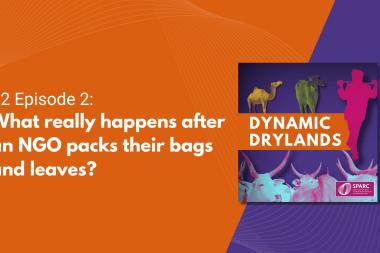Blog
Dynamic Drylands ep 4: 'Development on the margins: how should aid actors build resilience in fragile places?'
This episode of Dynamic Drylands podcast series 2 reflects on how the international climate and development community can support people living in the most fragile and hard-to-reach places.
Publisher SPARC
Below is an edited transcript of “Development on the margins: how should aid actors build resilience in fragile places?”, the latest episode of Dynamic Drylands podcast. We recommend listening to it in its original form for the full effect. You can do so on Acast, Amazon Music, Apple Podcasts, Spotify, or watch on YouTube below:
Amir Khouzam: We’re speaking here about places which are difficult to work in according to typical models of development. So, these are kind of places that are on the margins of the international system, but they’re not marginal populations—there are hundreds of millions of people who live in places affected by conflict and fragility.
Bola Mosuro: That’s Amir Khouzam, a research associate at think tank ODI Global. Amir is talking about the ‘conflict blind spot’ in development: the fact that, while many of the world’s poorest people live in fragile or conflict-affected places, they receive very little of available climate or development funding.
Working in fragile and conflict-affected places is tricky. Donors and development funds often see fragile countries as too risky to invest in. Most of the funding which does enter, flows to humanitarian response. But this focus on coping with crises isn’t building the long-term resilience people need to adapt to future shocks.
Welcome to Dynamic Drylands. I’m Bola Mosuro, a journalist and broadcaster and I’ve been reporting for the past 30 years.
In this episode, we’ll be hearing from Amir and Musaed Aklan. They’re two people who are working to close the conflict blind spot in development finance. We’ll be hearing about why the international aid community can’t afford to ignore these contexts, and what entry points exist for donors and development workers looking to make a difference.
First, what do we mean by fragile countries?
Amir: I think there are a lot of terms that we use to describe these countries: protracted crises or conflict-affected settings. I think what we really mean is countries or regions within countries where institutions are very weak or are fully engaged in looking at other issues, and so are not necessarily working on the kind of questions of development that might be present in a more stable setting. Often these are countries that are affected by security concerns or by conflict, and sometimes they're places where the state is not actually fully present at all and doesn't have control over parts of its territory.
Bola: The fact that these countries are often ranked as the most vulnerable to disasters, including climate change, is not some geographical accident. In fact, people living in these places are much more vulnerable to shocks, because they don’t have the institutions or government support they need. Amir explains:
Amir: People are very vulnerable in these settings. They're vulnerable to shocks, and those shocks include climate shocks, storms and droughts and extreme weather. And because they're so vulnerable, they have very little in reserve; those shocks hit harder in these places. So it's absolutely essential that we work on resilience building and climate adaptation in these places. But unfortunately, it's some of these places that are receiving the least amount of support because of the difficulties that come with operating in these settings.
I think one example where these things really come together is a place like Niger. Niger is a country where it's really obvious how climate risks, long-term environmental degradation and conflict affect people. You have very dramatic instances of the desert almost swallowing people's land and changes in patterns of communities who have long been mobile and moved in response to access to resources and other dynamics, but are now moving into areas where there are existing communities of farmers. Sometimes this is leading to competition or new interactions between communities. And there's an absence of the state there to manage these tensions. And at the same time, you have trans-border conflict, you have migration, you have displacement from conflict in neighbouring countries. You have non-state armed groups who are present in part of the country. And then a few years ago, you had a change in the government where the military replaced the previous authorities.
And so this has led to a whole set of new barriers to working in a country like Niger. Governments—Western governments—are limited in what they can do with the government of Niger. There are sanctions and legal restrictions on development, and the kind of support that that country has been reaching has reverted almost to traditional humanitarian assistance. But you still have all these risks, and actually they're getting worse.
Bola: Climate change is only making people in fragile countries more vulnerable. Let’s turn now to Musaed Aklan, a specialist in water and climate change with Yemen’s Sana’a Center for Strategic Studies:
Musaed Aklan: Climate change plays a critical role in Yemenis’ ongoing crisis. It increases tensions and conflict among the Yemeni population. So in recent years, Yemen has experienced an average of one cyclone per year, which increased dramatically compared to the historical pattern of one cyclone every five to six years. These small, frequent cyclones, floods have affected the communities, local communities and the fishermen, destroying homes, infrastructure and overall livelihoods. The storms have caused severe flooding, which not only threatens lives and property, but also displacement camps, worsening humanitarian conditions and has introduced even saltwater intrusion into the coastal areas and agriculture lands. So the impact of climate change is increasing, and it's impacting a lot. Even if Yemen is not contributing to this change itself, it is one of the countries impacted a lot by climate change.
Bola: But Musaed makes clear that Yemen’s ongoing crisis isn’t just because of climate change. Yemen’s recent history of war, fragile governance and deep fragmentation makes people more vulnerable to shocks, like floods:
Musaed: Yemen today is facing a mix of complexity, a lot of problems, environmental governance, conflict and political issues in Yemen, the conflict with the finance and climate challenges feed into each other, creating critical cycle of problems. Today, half of all water facilities have been destroyed or impacted by fighting, forcing many families to walk hours just to find water, and many millions of people have been displaced from their local areas. So for example, the water crisis was very critical before the war, and now it is even worse in terms of the water quality, quantity, accessibility and affordability. Today, most of the Yemenis, including 8.6 million children, lack safe water access, and this scarcity often sparks violence between communities themselves. So the governance weaknesses and political instability and collapse and breakdown mix things worse.
Bola: Amir and Musaed make it clear that politics and conflict have a direct impact on how people in Niger and Yemen are able to cope with shocks, like flooding. Aid and climate actors need to address these root causes if they are to make any headway in building people’s resilience. It is tricky—but it can be done. Let’s hear from both again, starting with Musaed:
Musaed: Work in conflict-affected countries is very critical, very risky, but it's very important and very needed, because without working in these conflict-affected countries the locals would suffer a lot, and most of them are not a part of these conflicts. So one of the points to support these countries is to ease the requirements of getting these funds, accelerate the process, which takes years, sometimes for a single project.
But also, I consider this as rights for these countries, it should be focused more also in the adaptations, rather than mitigation projects. So opening the climate finance windows for these countries is very important, and integrating conflict sensitivity and risk-informed approaches are very important. Working through locals and strengthening local leadership and ownership and ensure the future sustainability of these projects is also one of the key success points for any interventions or any funds.
Bola: Amir expands on the issue of positive intervention:
Amir Khouzam: There are a lot of things we can do to start now and to respond. There has been work beyond SPARC and beyond ODI, to look more broadly at what kind of action works in these settings. One is that programmes that are very deeply context specific and very informed by the actual realities and experiences of the people living in these settings usually work.
What we've also found is that the assumption that the more fragile or the more intense a conflict, the less can be done, is not always true. There is always action that is taking place. It might vary in form and vary in style and might not look like traditional climate action, but almost everywhere we've looked, something is possible, and in fact, actions to mitigate risk, longer-term risk are taking place. They're just taking place at a very small scale. So one thing that international actors who are used to operating at quite a big scale can do is start with what is already happening and start to scale it up.
Bola: This is a story about structural problems. When people don’t have the support they need, a shock—like a flood or drought—can quickly turn into a disaster.
Tackling the messy, political factors which make people vulnerable to shocks is understandably difficult. But, as Musaed and Amir make clear, entry points do exist. And donors can no longer afford to turn a blind eye. And we finish with Amir:
Amir: I think, for not just donors, but for everyone involved in the response to longer-term risks, climate change and environmental degradation in complex settings, the reason to engage now is because the costs of not doing so in the future will be enormous. And first and foremost, those are costs borne by people who live in those countries and these settings themselves.
Bola: Thank you to Amir Khouzam and Musaed Aklan for their expertise, and thank you for listening to Dynamic Drylands. I’m Bola Mosuro.
In the next episode, we hear how farming communities recover from the ravages of conflict—and what they can teach us about the best ways to support them.
Steve Wiggins: In almost all cases, agriculture recovered strongly, perhaps more strongly than anyone could have hoped, and much of the increase in production was coming from small farms. And now, how were smallholders doing that? Well, it was very simply by hard work. They were going back to their fields, fields which had often been abandoned for many years. Nevertheless, the increases in production were very, very considerable, and so output grew rapidly when peace was restored. But very surprisingly, they got very very little support from their governments to do so. They saw small farms, not very technical—they saw that as poverty and the past.
Bola: Dynamic Drylands is produced by the research-to-action programme ‘SPARC’: Supporting Pastoralism and Agriculture in Recurrent and Protracted Crises. It was funded with UK aid from the UK government, and managed by Cowater International in partnership with the International Livestock Research Institute, Mercy Corps, and ODI Global. Thank you to everyone who contributed to this series. For more information about the issues discussed in this podcast, visit the links in the show notes.
Hosted by Bola Mosuro. Contributors: Amir Khouzam and Musaed Aklan.
Dynamic Drylands is produced by the research-to-action programme Supporting Pastoralism and Agriculture in Recurrent and Protracted Crises (SPARC). This material has been funded by UK aid from the UK government; however the views expressed do not necessarily reflect the UK government’s official policies.



